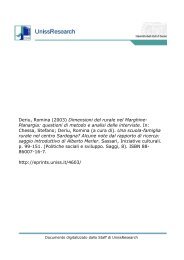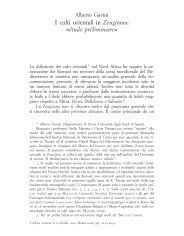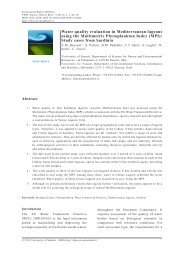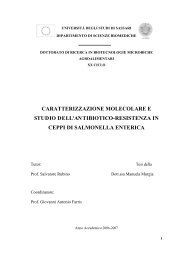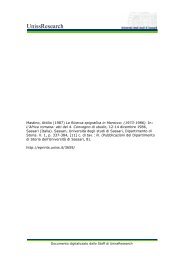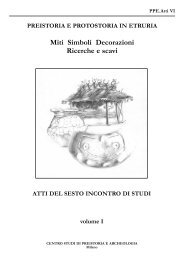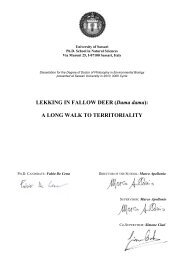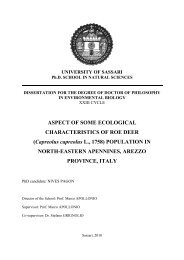L'Africa romana - UnissResearch - Università degli Studi di Sassari
L'Africa romana - UnissResearch - Università degli Studi di Sassari
L'Africa romana - UnissResearch - Università degli Studi di Sassari
Create successful ePaper yourself
Turn your PDF publications into a flip-book with our unique Google optimized e-Paper software.
118 Fadel Ali Mohamed - Joyce Reynolds<br />
kal and, perhaps, Annikeris. Some of these names surely entered the<br />
Greek onomastic repertoire as a result of marriages between Greeks and<br />
Libyans 9 • Others may have resulted from the practice among high-status<br />
Greeks of naming sons after foreigners with whom they had formed guestfriendshipslO.<br />
Either way these Libyan names show that despite intermittent<br />
tensions there were often amicable relationships between the leaders<br />
of Cyrenaican Greek society and those of the Libyans; we may posit similar<br />
relationships at all sociallevels, and probably an increasing degree<br />
of intermarriage and of cultural interchange during the Hellenistic and<br />
especially the Roman periods. At Cyrene itself the presence of Libyan<br />
names is dear but not as extensive as e.g. at Ptolemais and Taucheira;<br />
but there is other relevant evidence notably in the funerary portraiture ll ,<br />
as in the minor example illustrated by our new inscription no. 1, for what<br />
are generally held to be the Libyan features of many Cyrenaican faces.<br />
In the country <strong>di</strong>stricts a type of stele with more or less schematic representation<br />
of a human head was identified recent1y as probably Libyan l2 ;<br />
we add a new example of this type from Kharsa (ancient Chersis) near<br />
Derna (new inscription no. 2). Finally we offer the evidence of three new<br />
texts (new inscriptions no. 3-5), probably all from the same rock-cut tomb<br />
near Messa (ancient name controversial), a rural site in the territory of<br />
Cyrene. These list several deceased members of a family in which the<br />
Libyan name Aialas figures significant1y often, alongside Greek names<br />
which are most of them standard names in the area, but in the use of<br />
which there is some sign of imperfect control of Greek grammar. We<br />
take this to be yet another pointer to the conclusion that in the Hellenistic<br />
and Roman periods the population of Cyrenaica was a genuine ethnic<br />
and cultural mixture in which the Libyan element was an important<br />
factor.<br />
Addendum. Dr. Fadel Ali brought to the colloquium a copy of a very<br />
recent1y <strong>di</strong>scovered inscription probably from the tomb of an immigrant<br />
family. We publish it here as new inscription no. 6 to show how much<br />
9 Cf. MASSON, cito n. 6, on the implications of the marriage of Archidamus and a<br />
Libyan princess, PINDAR, Pyth. IX, 106.<br />
IO See G. HERMAN, Patterns of Name Diffusion within the Greek World and beyond,<br />
«Classical Quarterly», 40, 1990, pp. 349-363.<br />
11 Cf. E. ROSENBAUM, Cyrenaican Portrait Sculpture, London, 1960, pp. 13-28.<br />
12 J. REYNOLDS, L. BACCHIELLI, Catalogo delle stele funerarie antropomorfe, «QAL»,<br />
12, 1987, pp. 489-522.<br />
Some New Inscriptions from Cyrenaica 119<br />
more complex in origin was the population of Roman Cyrenaica than<br />
used to be assumed.<br />
New inscriptions<br />
1. White marble stele incorporating the bust of a young male (width 0.34<br />
x height 0.96 x depth 0.34) inscribed on one face, which is damaged on<br />
both sides. Found in the area of Cyrene; now i·n Cyrene Museum. Plate I<br />
Letters, probably I cent. AD: 0.025; square sigma (C-); L for È'trov.<br />
Fadel Ali and Reynolds, forthcoming in «Libya Antiqua».<br />
[? ... ] BUA11ç BaAEv<br />
vacat 'toç (È'trov) l' vacat<br />
Valens son of Valens<br />
Aged lO years<br />
The hairstyle of the portrait is consonant with a date in the second<br />
half of the first century AD.<br />
The name common to father and son is, of course, transliterated<br />
Latin (such names are fairly common in roman Cyrene); but the style<br />
of the portrait is greek, while the features suggest a libyan element in<br />
the family. We seem to see anice combination of three cultures in this<br />
boy and his memorial.<br />
2. Limestone stele with ru<strong>di</strong>mentary head above (width 0.25 x height 0.36)<br />
inscribed on one face. Found at Kharsa (ancient Chersis); now in Derna<br />
Museum. Plate II<br />
Letters, very irregular, 0.02-0.04; lunate epsilon except in l. 4, sigma<br />
and omega; probably L for È'trov, with superscript bar.<br />
È'trov ?year<br />
vacat yv' 53<br />
'Iaarov Jason<br />



